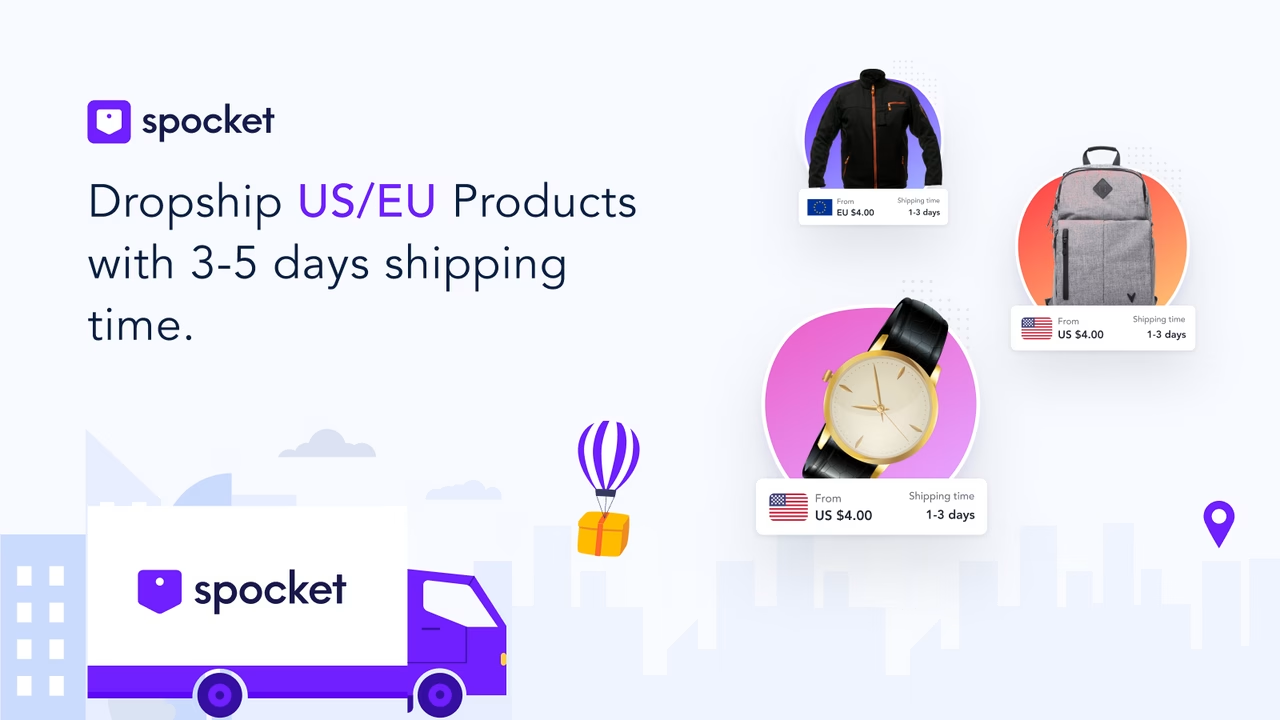When you begin exploring ways to generate passive income, you’ll quickly realize that not all income streams are created equal. To start dropshipping business is unique.
Passive income refers to earnings that require minimal effort to maintain once set up. While some methods, like investing in real estate or dividend stocks, demand substantial upfront capital, others, like dropshipping, offer a more accessible starting point.
Dropshipping is a business model with low overhead costs and scalable potential, making it particularly appealing for beginners.
Dropshipping operates on a straightforward principle: you sell products to customers without keeping the inventory yourself. Instead, you partner with suppliers who handle storage, packaging, and shipping, allowing you to focus on marketing and sales.
This hands-off fulfillment process makes it one of the most efficient avenues to begin earning passive income online. With millions of products available for dropshipping, the possibilities are vast and adaptable to various niches.

Dropshipping Success Overview
To succeed, you first need to understand how dropshipping complements the concept of passive income. Once your store is set up and optimized, automation tools and strategies can significantly reduce the time you spend managing operations.
Payment processing, inventory updates, and order fulfillment can all be automated, letting you generate sales even while you sleep. However, this does not mean dropshipping is a get-rich-quick scheme. Like any other business, it requires initial effort, strategic planning, and consistent refinement.
One of the key appeals of dropshipping is that its barrier to entry is remarkably low. You don’t need large storage units, manufacturing resources, or even upfront bulk purchases. The most crucial upfront investment you make is in your time and dedication to learning the process.
By mastering core elements like finding a niche, selecting reliable suppliers, and marketing online, you can steadily build a business that earns income passively over time. The first step is understanding how these pieces fit together systematically to set you up for success.
Basics of Dropshipping
Dropshipping is a business model where you, as the seller, run an online store without maintaining inventory. Instead of purchasing products in bulk, you partner with suppliers who fulfill orders on your behalf.
This means you only pay for the product after a customer places an order, effectively eliminating the need for upfront inventory investment.
At its core, the process involves three key parties: the customer, you (the retailer), and the supplier.
A typical sale works as follows: a customer places an order on your online store at retail price. You forward the order details and wholesale payment to your supplier. The supplier then ships the product directly to the customer’s address, often under your brand, preserving the trust of your customer base.
To get started with dropshipping, you need three essential components:
An e-commerce platform or website: Use platforms like Shopify, WooCommerce, or BigCommerce to build an online store tailored to your niche.
A reliable supplier: Partnering with dependable suppliers through marketplaces such as Spocket, AliExpress or Oberlo is crucial to ensure fast shipping and quality products.
I recommend Spocket for the following reasons:
- Vetted suppliers: Spocket suppliers are vetted for quality and efficiency.
- Fast shipping: 80% of Spocket’s suppliers are in the US or Europe.
- Branded invoices: Users can create branded invoices for their orders.
- Product discounts: Spocket offers discounts of 30–40% off retail prices.
- Product samples: Users can order product samples from the dashboard.
- Product sourcing and management: Users can manage product sourcing, inventory, and order tracking.
Start your Dropshipping Success with Spocket NOW!
A payment gateway: A secure method, like PayPal or Stripe, allows you to process customer payments seamlessly.
Dropshipping’s low overhead makes it an attractive venture, but you must understand critical elements such as selecting a profitable niche and choosing products that offer real value.
Additionally, effective marketing strategies, including paid advertising and social media outreach, are vital to driving traffic to your store and converting potential customers. By mastering these basics, you establish a robust foundation for your business.
Use the Best Dropshipping Supplier for US and EU Products.
Why Choose Dropshipping for Passive Income
When deciding on a passive income stream, you need to weigh the startup costs, scalability, time investment, and potential for automation. Dropshipping stands out as it offers a perfect mix of low barriers to entry and high growth potential.
Unlike traditional business models, you don’t need to manage inventory or deal with shipping logistics, allowing you to focus on marketing and customer experience.
The financial commitment needed to start is minimal. You don’t have to purchase products upfront, which eliminates the risk of holding unsold inventory. Instead, you only pay your supplier once you’ve made a sale. This model is appealing to anyone because it allows you to reinvest profits back into the business without draining personal savings or taking on debts.

Flexibility is another major advantage that likely matches your goals if passive income is the objective. Dropshipping doesn’t require you to tether yourself to one location, making it ideal if you seek geographical freedom. It also offers the option to work alongside a full-time job, ensuring you generate revenue without sacrificing existing commitments.
The scalability of this business model is unmatched. You can easily expand your store by adding new products and testing new niches without significant additional costs. Digital tools like data analytics and ad platforms streamline growth, making it simple to assess what works and adjust your strategies accordingly.
Finally, automation plays a critical role in making dropshipping an attractive passive income source. From automated order processing to email marketing systems, technology minimizes the daily workload, ensuring you spend less time managing tasks and more time enjoying the residual income.
This efficiency is the key to your decision. So, its time to start your dropshipping business.
Initial Research: Niches, Products, and Markets
Before diving into dropshipping, you need to focus on conducting thorough research to identify a niche, products, and markets where you can thrive.

This foundational step is crucial because it can make or break your business. Selecting the right niche sets the direction for your store and ensures you attract a specific audience that’s more likely to convert into customers.
1. Finding Your Niche
Start by analyzing your interests, expertise, and the current market demand. While passion is important, you should also evaluate how profitable your niche can be.
Use platforms like Google Trends to identify trends in consumer behavior and search demand. Consider niches that have sustained interest rather than fleeting fads.
In addition, check platforms like Reddit, Quora, and niche-specific forums to track conversations and pain points, as they often provide insights into unmet needs.
2. Selecting Products to Sell
Once you’ve narrowed down a niche, focus on identifying products that align with it. The ideal product is lightweight, easy to ship, and solves a problem for the target audience.
Tools like Spocket, Oberlo, AliExpress, and SaleHoo can help you scout for potential products while offering insights into pricing, popularity, and supplier reliability. Keep in mind factors like profit margins, seasonal demand, and competition.
Start Your Dropshipping Business Today →
Aim to avoid saturated or overly competitive products, as these can be harder to market for beginners.
3. Researching Target Markets
You need to determine the demographics and locations that are most likely to buy from your store. Use data-driven tools such as Facebook Audience Insights and Google Analytics to explore customer preferences, interests, and behaviors.
Focus on markets with substantial purchasing power, a strong appetite for e-commerce, and reliable shipping infrastructure. If you are planning to target global audiences, ensure the products you choose resonate with the cultural or regional needs of those markets.
By leveraging this research process, you can build a strong foundation for your dropshipping business, setting yourself up for success in the competitive e-commerce landscape.
Finding Reliable Suppliers and Tools
When it comes to dropshipping, choosing reliable suppliers is one of the most critical steps in building a successful business. Suppliers directly impact your product quality, shipping times, and ultimately your customer’s satisfaction.
To source dependable suppliers, you should begin with trusted online directories such as Spocket, AliExpress, Oberlo, or SaleHoo.
These platforms offer a variety of products and vendor reviews, simplifying the vetting process. I recommend Spocket for its outstanding features and reliabilities.

Start Your Dropshipping Business Today →
When evaluating suppliers, pay close attention to their reviews, ratings, and response times. Always order sample products first to assess quality firsthand. This step ensures that the products meet your expectations and allows you to understand the shipping timeline before advertising to your customers.
Look for suppliers that offer clear policies regarding returns and refunds, as this protects your business in case of defective or undelivered goods.
In addition to suppliers, you will need the right tools to streamline your operations. Start by selecting an e-commerce platform such as Shopify or WooCommerce to host your store. Both offer integrations with dropshipping apps like Spocket and DSers, allowing you to add products to your store and automate order fulfillment.
For market research, tools like Google Trends and Oberlo’s Product Statistics can help you identify trending products with strong demand.
To maintain a strong supplier relationship, ensure clear communication and professionalism. Promptly address any issues and provide feedback to suppliers when necessary. Reliable communication can build trust and improve the consistency of your partnership.
Always keep your customer’s expectations in mind and choose suppliers and tools aligned with your long-term business goals.
Start Your Dropshipping Business Today →
Setting Up an Online Store (Step-by-Step)
Creating a well-functioning online store is the foundation of your dropshipping business.

To start, you need to select an e-commerce platform best suited to your needs. Shopify, WooCommerce, or BigCommerce are popular options, but choose based on ease of use, scalability, and available features.
Sign up for an account and purchase a domain name that reflects your brand identity. Many platforms provide the option to buy and connect a domain directly, streamlining the process.
Next, configure your online store settings. Customize the theme to align with your niche and branding. Most platforms offer pre-designed templates, many of which are either free or affordable. Focus on making your website visually appealing, mobile-friendly, and easy to navigate. Update key sections like the homepage, product pages, FAQs, and the About Us page.
Proceed to set up your payment methods. Enable multiple payment options such as PayPal, credit/debit cards, and other widely used payment gateways. Many customers won’t convert if their preferred payment method isn’t available. Test each payment option to confirm everything is functioning correctly.
Now, integrate products from your chosen suppliers. Many dropshipping tools and apps, such as Spocket or Oberlo make importing products seamless. Ensure each product includes high-quality images, accurate descriptions, and competitive pricing. Organize your products into categories to keep your store user-friendly.
Finally, review the store’s legal policies. Add pages for terms and conditions, privacy policy, and shipping/return policies. Most e-commerce platforms provide templates to assist with this step. Completing these setup tasks builds a trustworthy and professional storefront.
Start Your Dropshipping Business Today →
Crafting a Marketing Plan: Driving Traffic to Your Store
An effective marketing plan is essential for driving traffic to your dropshipping store. To begin, you need to identify your target audience. Define who your customers are based on factors like age, location, interests, and spending habits.
This helps focus your marketing efforts on the right group of people after you start your dropshipping business.
Social media marketing serves as a powerful tool to promote your store. Platforms such as Instagram, Facebook, TikTok, and Pinterest allow you to showcase your products and build a community around your brand.
Schedule regular posts featuring high-quality images, engaging captions, and clear calls-to-action (CTAs) that direct people to your store. Consider leveraging paid ads on these platforms, as they allow you to target specific audience segments and enhance visibility.
Search engine optimization (SEO) is crucial for organic traffic. Optimize your product descriptions, blog content, and meta tags with relevant keywords that match your niche. Use tools like Mangools KWFinder, Google Keyword Planner, or SEMrush to identify high-ranking keywords. Additionally, create blog posts related to your products, providing valuable content that boosts your store’s credibility and search rankings.
Email marketing campaigns are another effective strategy. Collect email addresses through sign-up forms on your website and create automated email sequences for welcoming new subscribers, promoting sales, or offering exclusive discounts. Personalize these emails to make them feel more relevant to the recipient.
Start a 30-Day Free Trial. 2,500 free subscribers30-day with Beehiiv
Lastly, collaborate with influencers in your niche. Partner with micro or mid-tier influencers who align with your brand to promote your products. They can create authentic content that introduces their followers to your store, increasing both traffic and conversions.
By combining these strategies, you create a comprehensive marketing plan tailored to driving consistent traffic and building long-term brand awareness for your dropshipping business.
Overcoming Challenges in the Early Days
When you start your dropshipping business, expect to face several challenges.
The first hurdle often comes from choosing a niche. You may feel overwhelmed by the number of options available and worry about picking something either too unique or oversaturated. This is where market research becomes indispensable. Use tools like Google Trends or niche-specific keyword tools to identify product categories that balance demand and competition.
Another common challenge revolves around selecting reliable suppliers. Early on, you might encounter vendors with delayed shipping, inconsistent product quality, or poor communication. To mitigate this risk, conduct thorough vetting by checking reviews, requesting samples, and testing their responsiveness to queries.
Platforms like Spocket, AliExpress and Oberlo can offer helpful insights into supplier performance and reliability.
Start Your Dropshipping Business Today →
Setting up your online store also comes with its own obstacles. Depending on your technical skills, you may find it difficult to navigate e-commerce platforms like Shopify. It’s important to focus on creating a professional, user-friendly design while integrating essential features like payment gateways and automated order processing.
Tutorials and forums can serve as valuable resources during this phase.
Marketing your store is another area that might seem daunting in the beginning. If you don’t have significant experience in digital marketing, strategies like running Facebook ads or leveraging influencers can feel like uncharted territory.
Start with small test budgets and use analytics to refine your campaigns. Learning platforms such as YouTube or Udemy can provide step-by-step guidance.
Lastly, managing customer expectations and handling disputes can pose challenges as you build your brand. Be proactive in addressing inquiries, set clear shipping timelines, and create a transparent refund policy.
Quality customer service can turn early issues into opportunities to earn loyalty.
Scaling Up: Automating and Optimizing Operations

As your dropshipping business begins to grow, scaling up becomes essential to meet the increasing demands and position yourself for sustainable success. To effectively scale while maintaining efficiency, you must automate routine tasks and continuously optimize operations.
Automation is a powerful tool that saves time and minimizes manual errors.
Start by automating your order fulfillment process. Platforms like Shopify and apps such as Spocket, Oberlo or DSers can directly sync orders to your suppliers, ensuring faster processing with minimal intervention.
Similarly, automate email marketing by setting up workflows using tools like Beehiiv, Klaviyo or Mailchimp. For instance, you can create predefined email sequences for abandoned carts, promotional offers, and onboarding new customers. These systems allow you to maintain engagement with customers while focusing on growth.
Product research automation is equally crucial. Tools such as SaleHoo and Zik Analytics help analyze trending products by tracking competition, pricing, and demand in real time. Automating inventory tracking through integrations with suppliers helps you avoid overselling or running out of stock, directly impacting customer satisfaction.
Start Your Dropshipping Business Today →
Optimization is King
Optimization also plays a significant role in scaling after you start your dropshipping business. Focus on refining your website by improving loading speeds, simplifying navigation, and streamlining the checkout process. A user-friendly shopping experience reduces cart abandonment rates and increases conversions.

Utilize analytics platforms like Google Analytics to monitor site traffic, customer behavior, and weak points in your funnel. Optimize your ad campaigns regularly by analyzing ROAS (Return on Ad Spend) and reallocating budgets to high-performing ads.
As your business becomes more complex, consider outsourcing repetitive tasks. Hiring virtual assistants for customer service or product listing management can free up your time to focus on strategic decisions. Scaling requires balancing automation, optimization, and human support effectively.
By leveraging these strategies, you can grow your dropshipping business without becoming overwhelmed by operational complexities.
Start Your Dropshipping Business Today →
Lessons Learned and Key Takeaways
Navigating the world of dropshipping teaches you valuable lessons both about business and your ability to adapt. The process involves trial and error, but with persistence and strategy, you uncover the stepping stones to success to start dropshipping business. Here are the main points:
1. The Importance of Niche Selection
You quickly realize that trying to sell a product without understanding your target audience is a losing battle. Focusing on a specific niche allows you to tailor your marketing strategy, understand customer needs, and stand out from competitors.
A poorly chosen niche will result in wasted resources and minimal ROI.
2. Don’t Underestimate the Role of Market Research
Market validation isn’t simply about finding trendy products; it’s about identifying what drives demand. Tools like Google Trends, competitor analysis platforms, and keyword research play a pivotal role in pinpointing profitable opportunities.
These strategies save you from selling products no one cares to buy.
3. Strong Supplier Relationships Matter
Reliable suppliers are critical. You need to vet your suppliers thoroughly to ensure timely shipping, consistent product quality, and excellent communication. Trustworthy suppliers can elevate the efficiency of your store, while unreliable ones can harm your reputation.
4. Patience and Testing Are Non-Negotiable
You must test multiple ad campaigns, landing pages, and price points to determine what works for your audience. Results don’t happen overnight. Impatience often leads to impulsive decisions that hurt long-term success. Staying data-driven reduces the temptation to act on emotions.
5. Customer Experience Is Your Edge
Providing exceptional customer service often becomes your competitive advantage. Address inquiries promptly, communicate shipping updates clearly, and resolve complaints efficiently. Positive experiences can earn loyal customers and lower refund requests.
6. Automation is Your Ally
Dropshipping relies heavily on automation for efficiency. Using apps to manage inventory, fulfillment, and order tracking minimizes administrative burdens so you can focus on strategic growth. Ignoring automation leads to inefficiencies and burnout.
These lessons highlight the strategic and operational tweaks you must make to scale a dropshipping business effectively. Mistakes will happen, but staying adaptable ensures you grow from every challenge.
Tips for Beginners Starting a Dropshipping Business
To start a dropshipping business can feel overwhelming, but breaking it into manageable steps can set you up for success. Here are essential tips to help you get started on the right foot:
1. Choose a Niche Wisely
Focus on a specific niche where demand exists, but competition isn’t overwhelming. Research trends using tools like Mangools KWFinder, Google Trends or paid platforms such as SEMrush. Prioritize niches where potential customers are passionate, as this often increases purchase likelihood. Ensure the niche aligns with your interests if possible; it helps maintain motivation and build expertise.
2. Select Reliable Suppliers
Partnering with reliable suppliers is critical to ensure product quality and prompt shipping. Use platforms like Spocket, AliExpress, or Oberlo to vet suppliers. Look for consistent positive reviews, fast shipment processing times, and clear return policies. Conduct test orders to verify product quality before offering items in your store.
Start Your Dropshipping Business Today →
3. Build an Easy-to-Navigate Store
Use beginner-friendly platforms like Shopify or WooCommerce to set up your store quickly. Ensure a clean, professional design with intuitive navigation. Incorporate high-quality product images, clear descriptions, and trust-building elements like customer testimonials, live chat support, and secure payment badges.
4. Focus on Marketing
Successful dropshipping revolves around strong marketing efforts. Use social media platforms like Instagram, Facebook, and TikTok to reach your target audience. Run paid ads to drive traffic to your store.
Learn the basics of email marketing and consider influencer partnerships to expand brand visibility.
5. Understand Customer Service
Expect occasional customer complaints or questions. Prepare to respond promptly, addressing concerns effectively to maintain trust. Offering excellent customer service builds loyalty and encourages repeat purchases.
6. Track Metrics and Improve
Use analytics tools to monitor your stores performance. Track metrics such as conversion rates, website traffic, and bounce rates. Use this data to refine your strategies, optimize your store, and adjust your marketing campaigns for better results.
By focusing on these tips, you can lay a strong foundation for your dropshipping journey.
Start Your Dropshipping Business Today →
How to Stay Motivated and Consistent in Building Passive Income
Building a successful dropshipping business takes time, discipline, and resilience. To stay motivated and consistent throughout the process, you need a solid strategy and the right mindset.
Here’s how you can stay focused and energized as you work toward your passive income goals.
1. Set Clear and Realistic Goals
Define specific, measurable outcomes for your dropshipping business. For example, rather than saying, I want to make money, state your target earnings within a defined time frame. Break long-term goals into smaller milestones to give yourself a steady sense of accomplishment along the way.
2. Develop a Routine
Consistency thrives when you create structured daily habits. Dedicate specific hours to research, marketing, customer service, and store optimization. Treat your dropshipping business like a job, even if it’s part-time, to build discipline and ensure regular progress.
3. Educate Yourself Regularly
Staying informed about changes in market trends, eCommerce tools, and consumer behavior can keep you inspired. Enroll in online courses, listen to podcasts, or join forums to interact with other professionals in the industry. Knowledge is a powerful motivator.
4. Track Progress and Adapt
Regularly monitor your stores performance metrics such as sales, traffic, and conversions. Celebrate milestones to keep your spirits high, but also analyze setbacks. Use data to refine your strategies rather than letting challenges derail your progress.
5. Cultivate a Positive Mindset
Surround yourself with positivity. Follow influencers who share actionable advice rather than just showcasing success. Remember why you started this journey and focus on the freedom and income stability passive income can bring.
Motivation builds momentum, and momentum creates habits. Stick to your plan, and success will follow.
6. Reward Yourself
To maintain motivation, reward yourself after achieving significant milestones. Small incentives, whether it’s a short break, an experience, or a favorite treat, can reinforce your drive to keep moving forward.
By integrating these practices into your routine, you’ll nurture consistency and motivation, both of which are essential for building a sustainable dropshipping business.
Adjust these steps to fit your lifestyle and goals to make your journey more effective and rewarding.
Conclusion: Path to Dropshipping Success
If you want to start dropshipping business in 2025, you require careful planning, strategic execution, and continuous optimization. By following this comprehensive guide, you’ve learned how to research profitable niches, find reliable suppliers, set up your store, and implement effective marketing strategies.
Remember that success in dropshipping isn’t overnight – it requires persistence, testing, and adaptation to market changes.
Key takeaways for your dropshipping journey:
- Start with thorough market research
- Choose reliable suppliers and quality products
- Focus on building a professional brand
- Implement solid marketing strategies
- Provide excellent customer service
- Continuously optimize and scale your business
Take action today by implementing these strategies step by step. With dedication and the right approach, you can build a successful dropshipping business from scratch.
Start Your Dropshipping Journey Today →
FAQs
1. How much money do I need to start dropshipping?
The basic startup costs when you want to start dropshipping business include several key components:
Essential Investments:
- E-commerce platform subscription
- Domain name registration
- Initial marketing budget
- Product testing funds
- Business registration fees (varies by location)
While it’s possible to start dropshipping on a shoestring budget, having a reasonable investment fund increases your chances of success. The key is to start with enough capital to cover your basic platform costs and initial marketing efforts.
Most successful dropshippers recommend having enough funds to:
- Test multiple products
- Run initial marketing campaigns
- Cover platform fees for several months
- Handle unexpected expenses
- Maintain operations until profitability
Remember that while dropshipping requires less capital than traditional retail, investing too little can limit your ability to test products and marketing strategies effectively. Start with what you can afford, but be prepared to reinvest early profits back into the business.
2. What are the best products to start dropshipping in 2025?
Most profitable dropshipping products have these characteristics:
Winning Product Criteria:
- Price range: $20-70
- Profit margin: 30% minimum
- Solving specific problems
- Light weight (under 2kg)
- Non-seasonal appeal
- Low return rates
Current Trending Categories:
- Eco-friendly products
- Home organization
- Tech accessories
- Wellness products
- Pet supplies
3. How do I find reliable dropshipping suppliers?
Follow this process to identify trustworthy suppliers:
Step-by-Step Supplier Verification:
- Research multiple platforms (Spocket, AliExpress, CJDropshipping, etc.)
- Check supplier ratings and reviews
- Order sample products
- Verify shipping times
- Test customer service response
- Compare prices across suppliers
- Check product quality consistency
Start Your Dropshipping Business Today →
Red Flags to Watch For:
- Poor communication
- No quality guarantees
- Inconsistent pricing
- Long processing times
- Bad reviews
4. What is the average profit margin in dropshipping?
Typical profit margins in dropshipping break down as follows:
Profit Structure:
- Low-end products: 15-20%
- Mid-range products: 20-30%
- High-end products: 30-40%
- Premium products: 40%+
Factors Affecting Margins:
- Product cost
- Shipping fees
- Marketing expenses
- Platform fees
- Payment processing costs
- Customer service expenses
5. How long does it take to make first sale in dropshipping?
Timeline expectations for first sales:
Typical Scenarios:
- With paid advertising: 1-2 weeks
- Organic marketing only: 3-4 weeks
- Mixed marketing strategy: 2-3 weeks
Factors Influencing Timeline:
- Marketing budget
- Product selection
- Market competition
- Pricing strategy
- Website optimization
- Traffic quality
6. What are the biggest challenges in dropshipping?
Common challenges and solutions:
Major Challenges:
- Product Quality Control
- Solution: Regular supplier verification
- Sample ordering
- Customer feedback monitoring
- Shipping Times
- Solution: Local suppliers
- Clear communication
- Multiple shipping options
- Customer Service
- Solution: Automated responses
- Clear policies
- Proactive communication
- Market Competition
- Solution: Unique value proposition
- Niche focus
- Superior service
7. Which is better: General store or niche store?
Comparison of store types:
Niche Store Advantages:
- Targeted marketing
- Higher conversion rates
- Better customer loyalty
- Easier branding
- Lower marketing costs
General Store Benefits:
- Product testing flexibility
- Broader market appeal
- Risk diversification
- Easier scaling
- Multiple audience targeting
8. How do I handle returns and refunds in dropshipping?
Effective return policy management:
Key Elements:
- Clear return policy
- Standard 30-day window
- Customer-friendly approach
- Multiple resolution options
Process Steps:
- Receive return request
- Verify claim validity
- Provide return label
- Process refund
- Update inventory
- Document case
9. What are the most effective marketing strategies for dropshipping?
Proven marketing approaches:
Digital Marketing Mix:
- Facebook/Instagram ads
- Google Shopping campaigns
- Influencer partnerships
- Email marketing
- SEO optimization
- Content marketing
Budget Allocation:
- 40% product testing
- 30% scaling winners
- 20% retargeting
- 10% brand building
10. How do I scale my dropshipping business?
Strategic scaling approach:
Growth Strategy:
- Data Analysis
- Track metrics
- Identify winners
- Optimize costs
- Operation Optimization
- Automate processes
- Improve fulfillment
- Enhance customer service
- Marketing Expansion
- Increase ad spend
- Add marketing channels
- Expand target audience
- Product Development
- Add complementary products
- Expand product lines
- Improve offerings
Start Your Dropshipping Business Today →
Remember: Success in dropshipping comes from continuous learning, testing, and optimization. Stay updated with market trends and always focus on providing value to your customers.








